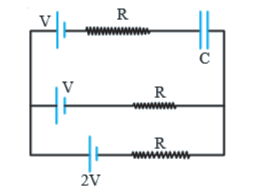Alternating current flowing through a certain electrical device leads over the potential difference across it by 90∘. State whether this device is a resistor, capacitor or an inductor.
To determine whether the electrical device is a resistor, capacitor, or inductor based on the given information that the alternating current (AC) leads the potential difference (voltage) by 90 degrees, we can analyze the behavior of these components in an AC circuit.
1. Understanding Phase Relationship:
- In AC circuits, the phase relationship between current and voltage is crucial. The phase difference indicates how much one waveform leads or lags behind another.
2. Phase Difference in Components:
- For a resistor: The current and voltage are in phase. This means that there is a phase difference of 0 degrees.
- For a capacitor: The current leads the voltage by 90 degrees (or π/2 radians). This means that when the voltage reaches its maximum value, the current is already at its maximum value.
- For an inductor: The current lags behind the voltage by 90 degrees (or π/2 radians). This means that when the voltage reaches its maximum, the current is still increasing towards its maximum.
3. Analyzing the Given Information:
- The problem states that the current leads the potential difference by 90 degrees. This matches the behavior of a capacitor.
4. Conclusion:
- Since the current leads the voltage by 90 degrees, we conclude that the electrical device in question is a capacitor.
Final Answer:
The device is a capacitor.
---
- In AC circuits, the phase relationship between current and voltage is crucial. The phase difference indicates how much one waveform leads or lags behind another.
- For a resistor: The current and voltage are in phase. This means that there is a phase difference of 0 degrees.
- For a capacitor: The current leads the voltage by 90 degrees (or π/2 radians). This means that when the voltage reaches its maximum value, the current is already at its maximum value.
- For an inductor: The current lags behind the voltage by 90 degrees (or π/2 radians). This means that when the voltage reaches its maximum, the current is still increasing towards its maximum.
- The problem states that the current leads the potential difference by 90 degrees. This matches the behavior of a capacitor.
- Since the current leads the voltage by 90 degrees, we conclude that the electrical device in question is a capacitor.
The device is a capacitor.
Similar Questions
The displacement current flows in the dielectric of a capacitor when the potential difference across its plates-
View SolutionThe displacement current flows in the dielectric of a capacitor when the potential difference across its plates-
View SolutionWrite the relation between electric power of a devices with potential difference across its two ends and its resistance .
View SolutionIn the given circuit, with steady current, the potential difference across the capacitor is
 View Solution
View SolutionAn alternating current of rms value 10 A is passed through a 12Ω resistor. The maximum potential difference across the resistor is
View SolutionName a device that helps to maintain a potential difference across a conductor.
View SolutionIn the given circuit, the potential difference across the 6μF capacitor in steady state is
 View Solution
View SolutionA current 0.2A flows in a wire of resistance 15Ω. Find the potential difference across the ends of the wire.
View SolutionHow is the current flowing in a conductor changed if the resistance of conductor is doubled keeping the potential difference across it the same ?
View SolutionIf the potential difference across the ends of a conductor is doubled, the current flowing through it gets
View Solution

